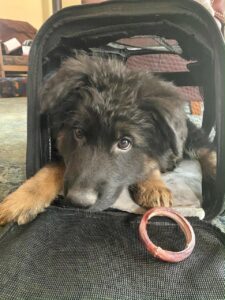By Fran Jewell
 Many people will research the best breeders they can find for a puppy of a breed they adore. Sometimes that means traveling to get them and bring them home. There are many great ways to help that new puppy have an easy trip home.
Many people will research the best breeders they can find for a puppy of a breed they adore. Sometimes that means traveling to get them and bring them home. There are many great ways to help that new puppy have an easy trip home.
I always suggest that you send an airline-approved Sherpa bag if flying, or an appropriate sized crate to the breeder ahead of time. Reputable breeders will many times crate or Sherpa bag train a puppy before the puppy is picked up.
When I have a litter of puppies, I start crate training them at 3 weeks old by putting a large, soft kitty “hut” for them to play and sleep in. It is a big hit, and hilarious to see three German shepherd puppies peeking out of the little hut! This helps them to learn the safety and comfort of a confined area in a very gentle fashion. Many reputable breeders will put a crate in with the puppies very early as well because they want the transition to the puppies’ new homes to be easy and enjoyable for everyone.
Sherpa bags, with openings on both ends, make it very easy for a puppy to learn to love to crawl in and pass through to the other side. Lots of treats in the middle teach them to stay there even if the ends are open. This experience will help the puppy to be totally comfortable during traveling.
To prepare for the airplane trip or car ride, be sure to pack a “go bag” of goodies that include extra potty pads for the inside of the crate or bag. Baby wipes are helpful too. Of course, a plastic bag to put used potty pads and baby wipes in is a must.
I also like to include a long-lasting chewy treat, such as a spiral bully stick or a stuffed marrow bone that has peanut butter in it. Both are available from good pet stores.
I do not allow puppies to go potty in the airport pet relief areas. There is simply too much risk of your puppy being exposed to an aggressive dog or disease. I also do not let a puppy relieve itself in a commonly used grass area for the same reason. I seek out unused places or simply let a puppy go in the bag on a potty pad. House training comes later.
It is important to bring a collar if the breeder does not provide one. I always provide a martingale collar that the puppies are already used to. Ask the breeder ahead of time for a measurement of the puppy’s neck so you can purchase the right size ahead of time. I don’t particularly recommend harnesses, primarily because I have seen little dogs and puppies get out of them very easily. A martingale collar is almost impossible for a small dog or puppy to get out of and does not damage their neck. Bringing a leash is also imperative, but not a flexible leash. A Flexi can actually scare a puppy if it accidentally gets dropped, or the leash can trip someone if extended too far. A puppy should be close to you at all times until you get home.
I also like to bring a bottle of Bach’s Rescue Remedy for pets. This usually has extremely good calming effects on the puppy. Bring some nice, soft, tasty treats that you can occasionally drop in from the top of the bag to keep the puppy happy and reward quiet behavior.
It is so exciting to get a new puppy! Being prepared for the trip home will make the transition so much easier. And, REMEMBER, training should happen the moment your puppy comes home. There are so many things you can teach, especially at the tender age of 8 or 9 weeks, without taking your pup to a class prior to all their shots being given.
Fran Jewell is an IAABC Certified Dog Behavior Consultant, NADOI Certified Instructor and the owner of Positive Puppy Dog Training, LLC in Sun Valley. For more information, visit positivepuppy.com or call 208-578-1565.


